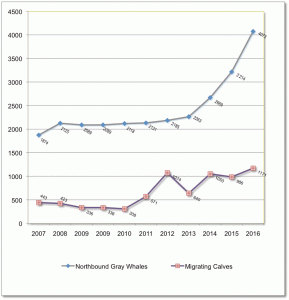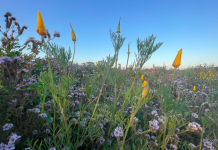
Tanner Walker
Staff Writer
Over 20,000 gray whales will pass by UCSB this spring on their journey between Mexico and Alaska. Gray whales spend their winters in Baja California, their summers in Alaska, and spend the remaining months traveling between the two. In total, their trip is over 10,000 miles round trip, one of the longest migrations of any mammal.
After feeding all summer long in the rich waters north west of Alaska, the whales head to warm, shallow lagoons in Mexico around November. Mothers head down earlier to reach the lagoon’s safety before their babies are born. Around the beginning of March, when the babies are a few months old, the whales start their trek back to Alaska.
Although the gray whale population has recovered from centuries of whaling, many still believe monitoring the species’ numbers is crucial. Following the whale’s migration route along the west coast of North America, there are seven designated observation points, as shown in the migration map. At these observation outposts, individuals, volunteer organizations, or conservation groups count the number of whales sighted, their direction, and whether they are traveling alone or as a mother/calf pair.
One of those organizations, Gray Whales Count, uses Coal Oil Point (more commonly known to students as Sands or Deveraux) as their observation point. The group spends nearly 100 consecutive days from February through May monitoring gray whales on their passage north through the Santa Barbara Channel. From 9 am to 5 pm every day, members of Gray Whales Count and volunteers watch from the edge of the cliff for signs of migrating whales.
“We wanted to create a project that was meaningful scientifically but also something that the community could participate in as well as view,” said Michael Smith, the organization’s founder.
“Its great to see people come up and check the board to see how many we’ve got today or say ‘wow, I didn’t know you could see whales from here!’”
Building a project that is visible and open to community involvement was important to Smith for a few reasons. Gray Whales Count is not a university program and it does not receive government funding other than grants. “We get donations from private foundations as well as support from individuals and local corporations,” said Smith.
Community support is also essential to the organization because volunteers make up a large part of their workforce. Aside from Smith and research assistant Lulu Bates, Gray Whales Count is a volunteer driven group.
“We have a great base of about 100 volunteers,” said Bates. “They come for two hour shifts with two volunteers per shift.”
So far this year, the group has spotted 75 gray whales. “We are essentially counting two different migrations here,” said Smith. “The first part of it is the general migration which includes males and females, both mature and juvenile, who are not associated with calves.”
“We have those guys coming through right now until the beginning of April,” Bates. “Then, in April and May, we will have the mothers and the calves coming up, which is awesome. They come close to shore and they spend a lot of time at the surface. The calves are learning to breath, how to swim, and some of them will even breach.”
Coal Oil Point’s unique location make it one of the most ideal land based whale watching spots in California. The point stits in the middle of the Santa Barbara Channel, a calm passageway that runs between the coast and Channel Islands, from Point Mugu to Point Conception. Going around the Channel and cutting between the islands would give traveling whales a more direct, shorter route, but many prefer to pass through the sheltered channel as a break from the strong currents in the open ocean.
“About 20 percent of the general population and 90 percent of the mothers and calves pass through the channel,” said Smith. Following the channel is especially helpful for mothers because their calves are only two or three months old at the start of the trip and need an easy journey if they are to arrive in Alaska healthy and on time.
“If the mother and calf get separated, the calf is going to die,” Smith said. “It’s much easier to control that situation by coming in close to shore. The mother can also stop and do a little feeding for herself. She loses a third of her body weight between birth and this migration.”

At the end of the season, after Gray Whales Count has their final count tallied, they send the data to NOAA for use in a larger project.
“We work directly with NOAA and share our data with them. They create the estimates of the entire population,” said Smith. There’s a sight just south of Carmel where they do exactly what we are doing here: use their binoculars, see the whales, and total them all up. The migration goes 24/7, so just like us they’re doing samples from each day.”
Even if NOAA and Gray Whales Count had funding and technology available to watch for whales around the clock, there would inevitably be individuals who pass by unnoticed or take a route farther away from the coastline and out of view. Without the ability to spot every migrating whale, the groups rely on their data to make generalizations for totaling the entire species.
“There’s an algorithm that we can put our data into and it will extrapolate an estimate of the total number of whales migrating,” said Bates. Gray Whales Count also runs their data through programs to calculate how far the whales are from the point they were spotted.
The data NOAA and Gray Whales Count collects is used to see population trends and assess the health of the species as a whole, as shown in the whale population graph.
“Its an important job to continue to monitor the gray whale population,” Smith said. “Gray whales were on the endangered species list when it came out in 1972 and they were taken off in 1994.”
Although they are no longer listed as endangered, constantly monitoring the species’ population is important because changing environmental conditions can mean that they are still vulnerable, according to Smith. Five years after the gray whale was taken of the endangered species list, a third of the population was lost in a single year.
“It was ice in Alaska that just shut them out of their feeding area,” Smith said. “They starved to death, which is just awful, but they’ve come back wonderfully.”
For Smith, starting Gray Whales Count and spending nearly a third of his year watching whales from “counter point” as it’s known during the migration, has been rewarding beyond expectation.
“It is admittedly a lot of work,” said Smith. “But it’s very fun and the community here is just so wonderful. I’ve had so many wonderful people associated with it. Last year, half of the people had been part of five or more surveys. It’s just invaluable, they’re wonderful people and they’re passionate and caring.”


















Thanks for keeping focus on the Grey’s heading back up our coast. Knowing more about our fellow living things helps us value and want to protect them!
Comments are closed.